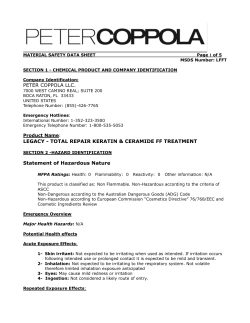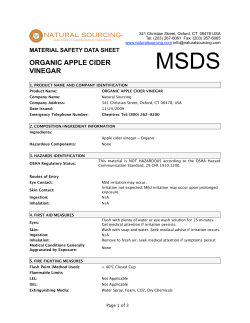
Document 258992
THIS DOCUMENT IS THE PROPERTY OF MICROMERITICS INSTRUMENT CORP. AND MAY BE REPRODUCED IN WHOLE OR IN PART. 004/16263/00MSDS Cover Sheet INSTRUMENT CORPORATION ONE MICROMERITICS DR. NORCROSS, GA 30093-1877 U.S.A. DWN BY ENGR J.Pittman J. Mocny MSDS, Tween 20 ENGR SIG HR SIG QA SIG – REV Formal Release REVISION DESCRIPTION JP 08/18/06 BY DATE 060293 CHK REL. NO. ES SIG SIZE A NUMBER 004/16263/00MSDS PAGE X of 5 Micromeritics Material Safety Data Sheet Title : Tween 20 Date of Preparation : 08/03/2006 MSDS No. : 004/16263/00MSDS Revision : – Section 1 - Chemical Product and Company Identification Product/Chemical Name: Tween 20 Chemical Formula: n/a Catalog Numbers: BP337-100, BP337-500 Other Designations: Campul; PMSL Supplier: Micromeritics Instrument Corp. Contact: 1 Micromeritics Dr. Phone: Norcross, GA 30093-1877 USA Fax: Manufacturer: Fisher Scientific, 1 Reagent Lane, Fair Lawn, NJ. 07410 (201) 796-7100, (800) 424-9300 Human Resources (770) 662-3620 (770) 662-3696 Section 2 - Composition / Information on Ingredients Ingredient Name Polysorbate 20 CAS Number 9005-64-5 % wt 100 Trace Impurities: OSHA PEL Ingredient TWA STEL ACGIH TLV TWA STEL NIOSH REL TWA STEL Section 3 - Hazards Identification ¶¶¶¶¶ Emergency Overview ¶¶¶¶¶ Potential Health Effects Appearance: Light amber to amber liquid Caution – May cause eye and skin, May cause respiratory and digestive tract irritation. Target Organs: none Potential Health Effects Eye: May cause mild eye irritation Skin: May cause skin irritation Ingestion: May cause gastrointestinal irritation with nausea, vomiting and diarrhea. Inhalation: May cause respiratory tract irritation Chronic Effects: Adverse reproductive effects have been reported in animals. Micromeritics Instrument Corp. and Micromeritics Analytical Services www.micromeritics.com www.particletesting.com Surface Area - Porosity - Density - Particle Size, Shape & Count - Catalytic Activity - Surface Energy - Analytical Services Page 1 of 4 NIOS H IDLH MSDS No. 004/16263/00MSDS Tween 20 Rev: – Section 4 - First Aid Measures Eyes: Flush eyes with plenty of water for at least 15 minutes, occasionally lifting the upper and lower eyelids. Get medical aid. Skin: Flush skin with plenty of water for at least 15 minutes while removing contaminated clothing and shoes. Get medical aid if irritation develops or persists. Wash clothing before reuse. Ingestion: Never give anything by mouth to an unconscious person. Get medical aid. Do not induce vomiting. If victim is conscious and alert, give 2-4 cupfuls of milk or water. Inhalation: Remove from exposure and move to fresh air immediately. If not breathing, give artificial respiration. If breathing is difficult, give oxygen. Get medical aid if cough or other systems appear. Notes to Physician: Treat symptomatically and supportively. Section 5 - Fire-Fighting Measures General Information: As in any fire, wear a self-contained breathing apparatus in pressure-demand, MSHA/NIOSH (approved or equivalent), and full protective gear. Extinguishing Media: In case of fire, use water, dry chemical, chemical foam, or alcohol-resistant foam. Flash Point: > 150 deg C (> 302.00 deg F) Autoignition Temperature: Not Applicable NFPA Explosion Limits, Lower: Not Available 1 Upper: Not Available NFPA Rating: (estimated) Health: 1; Flammability: 1; Instability: 0 1 0 - Section 6 - Accidental Release Measures General Information: Use proper personal protective equipment as indicated in Section 8. Spills / Leaks: Absorb spill with inert material (e.g. vermiculite, sand or earth), then place in suitable container. Clean up spills immediately, observing precautions in the Protective Equipment section. Avoid generating dusty conditions. Provide ventilation. Section 7 - Handling and Storage Handling: Use with adequate ventilation. Avoid prolonged or repeated contact with skin. Avoid contact with eyes, skin, and clothing. Keep container tightly closed. Avoid ingestion and inhalation. Storage: Keep from freezing. Store in a tightly closed container. Store in a cool, dry, well-ventilated area away from incompatible substances. Store at around 20OC Section 8 - Exposure Controls / Personal Protection Engineering Controls: Use adequate ventilation to keep airborne concentrations low. Use adequate general or local exhaust ventilation to keep airborne concentrations below the permissible exposure limits. Exposure Limits: Chemical Name ACGIH NIOSH OSHA – Final PELs Micromeritics Instrument Corp. and Micromeritics Analytical Services www.micromeritics.com www.particletesting.com Surface Area - Porosity - Density - Particle Size, Shape & Count - Catalytic Activity - Surface Energy - Analytical Services Page 2 of 5 MSDS No. 004/16263/00MSDS Tween 20 Rev: – Polysorbate 20 None listed None listed None listed OSHA Vacated PEL’s: Polysorbate 20: No OSHA Vacated PELs are listed for this chemical. Personal Protective Equipment Eyes: Wear safety glasses and chemical goggles if splashing is possible. Wear appropriate protective eyeglasses or chemical safety goggles as described by OSHA’s eye and face protection regulations in 29 CFR 1910.133 or European Standard EN166. Skin: Wear appropriate protective gloves and clothing to prevent skin exposure. Wear appropriate protective gloves to prevent skin exposure. Clothing: Wear appropriate protective clothing to prevent skin exposure. Respirators: Wear a NIOSH/MSHA or European Standard EN 149 approved full-face piece airline respirator in the positive pressure mode with emergency escape provisions. Follow the NIOSH/MSHA or European Standard EN 149 approved respirator if exposure limits are exceeded or if irritation or other symptoms are experienced. Section 9 - Physical and Chemical Properties Physical State: Liquid Appearance: Light amber to amber Odor: None reported pH: Not available Vapor Pressure: Not available Vapor Density: Not available Evaporation Rate: Not available Viscosity: Not available Boiling Point: > 100 deg C Freezing/Melting Point: Not available Decomposition Temperature: Not available Solubility: 100 g/l Specific Gravity / Density: 1.1060 Molecular Formula: C58H114O26 Molecular Weight: 1226.7824 Section 10 - Stability and Reactivity Chemical Stability: Stable under normal temperatures and pressures. Conditions to Avoid: Incompatible materials. Incompatibilities with other Materials: Oxidizers Hazardous Decomposition Products: Carbon monoxide, carbon dioxide. Hazardous Polymerization: Has not been reported. Section 11 - Toxicological Information RTECS#: CAS#: 9005-64-5: TR7400000 LD50 / LC50: CAS#: 9005-64-5: Oral, mouse: LD50 > 33 mg/kg; Oral, rat: LD50 = 367000 µL/kg; Carcinogenicity: CAS#: 9005-64-5: Not listed by ACGIH, IARC, NTP, or CA Prop. 65 Epidemiology: No information available Teratogenicity: No information available Reproductive Effects: Adverse reproductive effects have occurred in experimental animals. Mutagenicity: No information available Neurotoxicity: No information available Micromeritics Instrument Corp. and Micromeritics Analytical Services www.micromeritics.com www.particletesting.com Surface Area - Porosity - Density - Particle Size, Shape & Count - Catalytic Activity - Surface Energy - Analytical Services Page 3 of 5 MSDS No. 004/16263/00MSDS Tween 20 Rev: – Section 12 - Ecological Information Ecotoxicity: No data available. No information available. Environmental: No information available. Physical: No information available. Other: None. Section 13 - Disposal Considerations Chemical waste generators must determine whether a discarded chemical is classified as a hazardous waste. US EPA guidelines for the classification determination are listed in 40 CFR Parts 261.3. Additionally, waste generators must consult state and local hazardous waste regulations to ensure complete and accurate classification. RCRA P-Series: None listed RCRA U- Series: None listed Section 14 - Transport Information United States DOT: Not regulated as a hazardous material. Canada TDG: Not regulated. Section 15 - Regulatory Information UNITED STATES FEDERAL: TSCA CAS#: 9005-64-5 is listed on the TSCA inventory. Health & Safety Reporting List: None of the chemicals are on the Health and Safety Reporting List Chemical Test Results: None of the chemicals in this product are under a Chemical Test Rule Section 12b: None of the chemicals are listed under TSCA Section 12b. TSCA Significant New Use Rule: None of the chemicals in this material have a SNUR under TSCA CERCLA Hazardous Substances & Corresponding RQ’s: None of the chemicals in this material have an RQ SARA Section 302 Extremely Hazardous Substances: None of the chemicals in this product have a TPQ SARA Codes: CAS# 6381-92-6: immediate Section 313: No chemicals are reportable under Section 313 Clean Air Act: This material does not contain any hazardous air pollutants This material does not contain any Class 1 Ozone depletors This material does not contain any Class 2 Ozone depletors Clean Water Act: None of the chemicals in this product are listed as Hazardous Substances under the CWA. None of the chemicals in this product are listed as Priority Pollutants under the CWA. None of the chemicals in this product are listed as Toxic Pollutants under the CWA. OSHA: None of the chemicals in this product are considered highly hazardous by OSHA. State: CAS#: 9005-64-5 is not present on state lists from CA, PA, MN, MA, FL, or NJ. California Prop 65: California No significant risk Level: None of the chemicals in this product are listed. EUROPEAN / INTERNATIONAL REGULATIONS: Micromeritics Instrument Corp. and Micromeritics Analytical Services www.micromeritics.com www.particletesting.com Surface Area - Porosity - Density - Particle Size, Shape & Count - Catalytic Activity - Surface Energy - Analytical Services Page 4 of 5 MSDS No. 004/16263/00MSDS Tween 20 Rev: – European Labeling in Accordance with EC Directives Hazard Symbols: Not available. Risk Phrases: Safety Phrases: WGK (Water Danger / Protection): CAS#: 9005-64-5 :1 Canada – DSL / NDSL Canada – WHMIS Section 16 - Other Information Prepared By: J. Pittman Revision Notes: Disclaimer: The information and recommendations set forth herein are taken from sources believed to be accurate as of the date hereof; however the original manufacturer, Fisher Scientific, makes no warranty with respect to accuracy of the information or the suitability of the recommendations, and assumes no liability to any user therof. MSDS Creation Date (by Fisher Scientific): 07-15-1999 Last Revision Date (by Fisher Scientific): Revision #6 – 06-19-2006 Micromeritics Instrument Corp. and Micromeritics Analytical Services www.micromeritics.com www.particletesting.com Surface Area - Porosity - Density - Particle Size, Shape & Count - Catalytic Activity - Surface Energy - Analytical Services Page 5 of 5
© Copyright 2025









